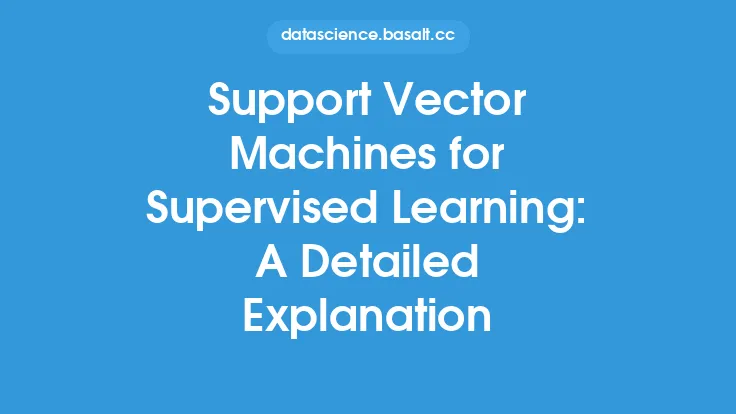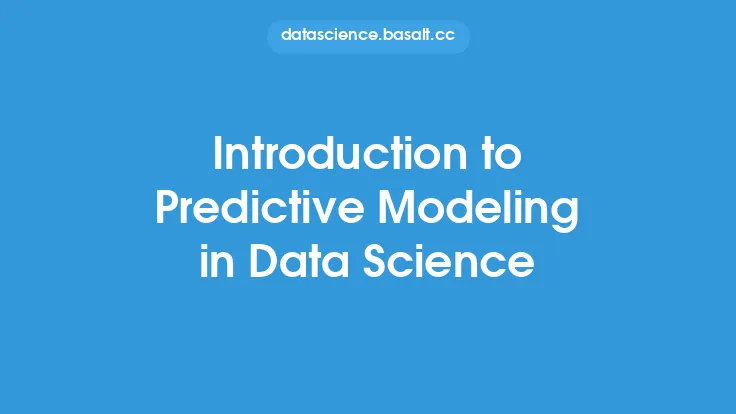Support Vector Machines (SVMs) are a type of supervised learning algorithm used for classification and regression tasks in data mining. They have become a popular choice among data miners due to their ability to handle high-dimensional data, non-linear relationships, and noisy datasets. In this article, we will delve into the world of SVMs, exploring their history, theory, and applications in data mining.
History of Support Vector Machines
The concept of Support Vector Machines was first introduced by Vladimir Vapnik and Alexey Chervonenkis in the 1960s. However, it wasn't until the 1990s that SVMs gained popularity as a powerful tool for classification and regression tasks. The key idea behind SVMs is to find the optimal hyperplane that maximally separates the classes in the feature space. This hyperplane is called the decision boundary, and it is used to make predictions on new, unseen data.
Theory of Support Vector Machines
The theory of SVMs is based on the concept of margin maximization. The margin is the distance between the decision boundary and the nearest data points, called support vectors. The goal of SVMs is to find the decision boundary that maximizes the margin, thereby minimizing the risk of misclassification. SVMs can be used for both linear and non-linear classification tasks. In the case of linear classification, the decision boundary is a hyperplane that separates the classes. For non-linear classification, the data is mapped to a higher-dimensional space using a kernel function, and the decision boundary is found in this new space.
Types of Support Vector Machines
There are several types of SVMs, each with its own strengths and weaknesses. The most common types of SVMs are:
- Linear SVM: Used for linear classification tasks, where the decision boundary is a hyperplane.
- Non-linear SVM: Used for non-linear classification tasks, where the data is mapped to a higher-dimensional space using a kernel function.
- Soft Margin SVM: Used for noisy datasets, where the decision boundary is allowed to make some mistakes.
- Hard Margin SVM: Used for noise-free datasets, where the decision boundary is not allowed to make any mistakes.
- Support Vector Regression (SVR): Used for regression tasks, where the goal is to predict a continuous output variable.
Kernel Functions in Support Vector Machines
Kernel functions play a crucial role in SVMs, as they allow the algorithm to operate in higher-dimensional spaces without explicitly mapping the data. The most common kernel functions used in SVMs are:
- Linear kernel: Used for linear classification tasks.
- Polynomial kernel: Used for non-linear classification tasks, where the data is mapped to a higher-dimensional space using a polynomial function.
- Radial Basis Function (RBF) kernel: Used for non-linear classification tasks, where the data is mapped to a higher-dimensional space using a Gaussian function.
- Sigmoid kernel: Used for non-linear classification tasks, where the data is mapped to a higher-dimensional space using a sigmoid function.
Applications of Support Vector Machines
SVMs have a wide range of applications in data mining, including:
- Text classification: SVMs can be used to classify text documents into different categories, such as spam vs. non-spam emails.
- Image classification: SVMs can be used to classify images into different categories, such as objects vs. backgrounds.
- Bioinformatics: SVMs can be used to classify proteins into different functional categories.
- Financial forecasting: SVMs can be used to predict stock prices and portfolio returns.
Advantages of Support Vector Machines
SVMs have several advantages that make them a popular choice among data miners, including:
- High accuracy: SVMs can achieve high accuracy on a wide range of classification and regression tasks.
- Robustness to noise: SVMs are robust to noisy datasets and can handle missing values.
- Ability to handle high-dimensional data: SVMs can handle high-dimensional data without suffering from the curse of dimensionality.
- Flexibility: SVMs can be used for both linear and non-linear classification tasks.
Disadvantages of Support Vector Machines
Despite their advantages, SVMs also have some disadvantages, including:
- Computational complexity: SVMs can be computationally expensive, especially for large datasets.
- Choice of kernel function: The choice of kernel function can significantly affect the performance of SVMs.
- Overfitting: SVMs can suffer from overfitting, especially when the number of features is large.
Conclusion
Support Vector Machines are a powerful tool for classification and regression tasks in data mining. Their ability to handle high-dimensional data, non-linear relationships, and noisy datasets makes them a popular choice among data miners. By understanding the theory and applications of SVMs, data miners can use them to solve a wide range of problems, from text classification to financial forecasting. While SVMs have their advantages and disadvantages, they remain a key technique in the data miner's toolkit.





